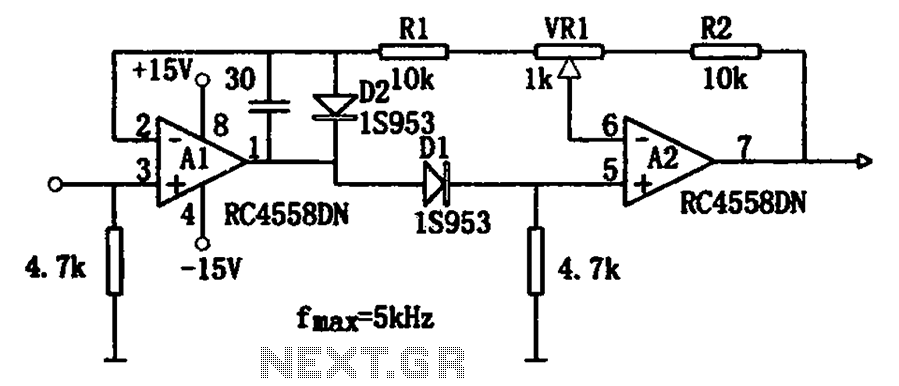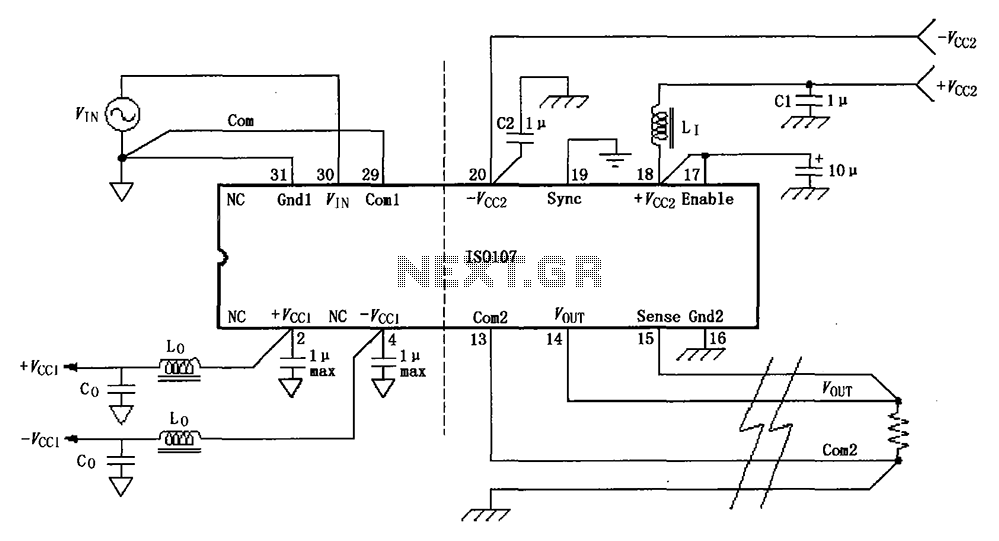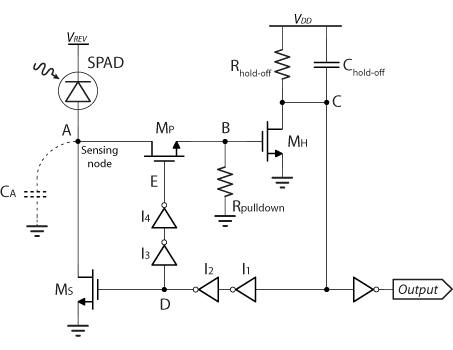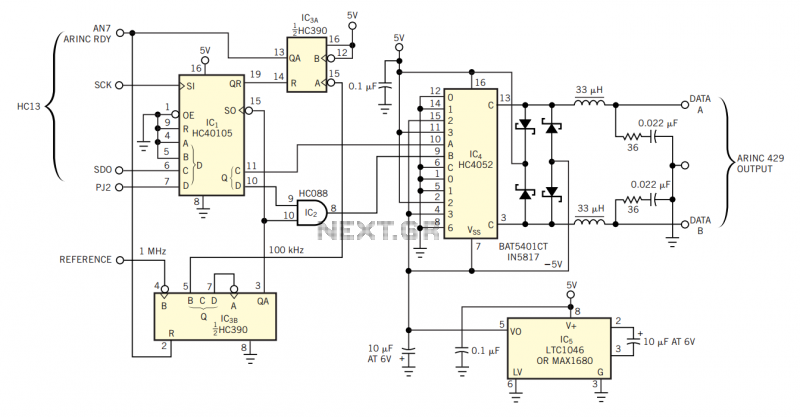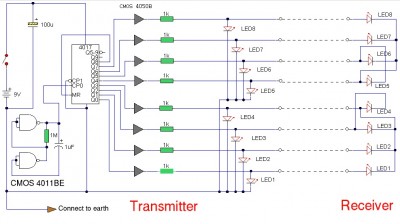
MAX1516 charge pump drive circuit diagram
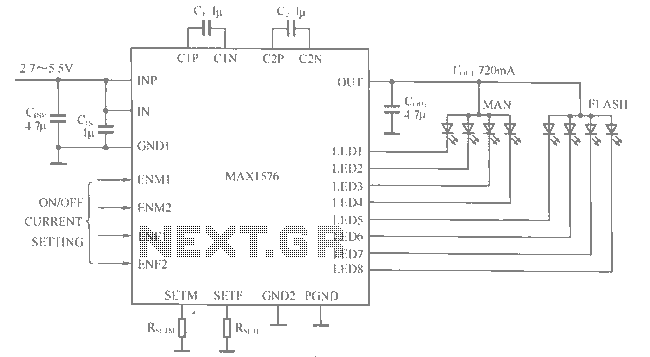
The MAX1516 charge pump drives up to 8 white LEDs with constant current regulation to achieve uniform light intensity, capable of delivering up to 30mA per LED for backlighting. The flash group LEDs (LED5 to LED8) are individually controlled, allowing for a maximum drive current of 100mA for each LED, totaling 400mA. Utilizing an adaptive charge pump operating in 1x, 1.5x, and 2x modes along with low-dropout current regulators, the MAX1576 achieves high efficiency across the entire voltage range of a lithium-ion battery. With a fixed switching frequency of 1MHz, the circuit requires only very small external components, and the regulation scheme is optimized to minimize electromagnetic interference (EMI) and input ripple. The maximum current for the main LED is adjustable using two external resistors, with the ENM1 and ENM2 pins setting it to 10%, 30%, or 100% of the maximum current. Similarly, the ENF1 and ENF2 pins allow for flash LED current settings of 20%, 40%, or 100%. Each pair of control pins can be connected for single-wire, serial pulse dimming control. Key technical features include the ability to drive up to 8 LEDs at 30mA for backlighting and 400mA for flash, achieving an average efficiency of 85% throughout the lithium-ion battery discharge process, with LED current matching accuracy of 0.7%. The adaptive mode switching enables flexible brightness control, and the single-wire, serial-pulse interface supports dimming from 5% to 100%, with logic level 3. The device operates with low input ripple and EMI, consuming only 0.1A in shutdown mode, and supports a power supply voltage range of 2.7V to 5.5V. It features a soft start function to limit inrush current, output overvoltage protection, and thermal shutdown protection. The MAX1576 is available in a 4mm x 4mm 24-pin thin QFN package, with a maximum thickness of 0.8mm. A typical application circuit for the MAX1576 charge pump white LED driver is illustrated in the accompanying figure.
The MAX1576 charge pump is designed to efficiently drive multiple white LEDs, making it suitable for applications requiring bright and uniform illumination, such as in mobile devices and portable electronics. The charge pump's ability to operate in different modes allows it to adapt to varying load conditions, optimizing power consumption while maintaining performance. The individual control of the flash group LEDs provides flexibility in design, enabling features such as camera flash or notification lights.
The implementation of low-dropout current regulators ensures that the output current remains stable even with variations in input voltage, which is crucial for battery-operated devices. The fixed 1MHz switching frequency minimizes the size of external components, allowing for compact circuit designs. The low EMI and input ripple characteristics are essential for maintaining signal integrity in sensitive electronic applications.
The adjustable current settings via external resistors provide designers with the capability to fine-tune the LED brightness according to specific requirements, enhancing user experience. The soft start feature prevents sudden inrush currents that could damage the LEDs or other components in the circuit. Protection features such as output overvoltage and thermal shutdown further enhance the reliability of the design, making the MAX1576 a robust solution for LED driving applications.
Overall, the MAX1576 charge pump presents a comprehensive solution for driving white LEDs with high efficiency, flexibility, and reliability, making it an ideal choice for modern electronic devices where space and power efficiency are critical.MAX1516 charge pump drives up to 8 from light LED, with a constant current regulation, in order to achieve a uniform light intensity, it can drive up to 30mA each LED, used for backlighting. Flash group LED (LED5 ~ LED8) is individually controlled, and capable of 100mA drive current for each LED (total of 400mA). By using an adaptive 1 , 1.5 , 2 mode charge pump and low-dropout current regulators, MAX1576 can achieve high efficiency over a lithium-ion battery entire voltage range.
Since the fixed switching frequency of 1MHz, only the use of very small external components, regulation scheme is optimized to ensure low EMI and low input ripple. Maximum MAX1576 uses two external resistors to set the main LED flash and LED (100%) current. ENM1 and ENM2 pin main LED current is set to 10% of the maximum current, 30% or 100%. ENF1 ENF2 pin and the flash LED current is set to 20% of the maximum current, 40% or 100%. In addition, each pair of control pins can be connected together to achieve single-wire, serial pulse dimming control.
Main technical characteristics (1) MAX1576's O drive up to 8 LED. 30mA drive for backlighting, 400mA drive for flash. the entire lithium-ion battery discharge process can achieve 85% average efficiency, LED current matching accuracy of 0.7%. adaptive 1 , 1.5 , 2 mode switching, flexible brightness control. single-wire, serial-pulse interface (5% to 100%), 2 (Level 3) for the number of logic. low input ripple and EMI, 0.1 A low shutdown current. power supply voltage range of 2.7 ~ 5.5V. has a soft start to limit inrush current, output overvoltage protection and thermal shutdown protection.
MAX1576 4mm 4mm 24-pin thin QFN package (maximum thickness of 0.8mm). (2) Typical Application Circuit MAX1576 charge pump white LED driver circuit as shown in FIG.
The MAX1576 charge pump is designed to efficiently drive multiple white LEDs, making it suitable for applications requiring bright and uniform illumination, such as in mobile devices and portable electronics. The charge pump's ability to operate in different modes allows it to adapt to varying load conditions, optimizing power consumption while maintaining performance. The individual control of the flash group LEDs provides flexibility in design, enabling features such as camera flash or notification lights.
The implementation of low-dropout current regulators ensures that the output current remains stable even with variations in input voltage, which is crucial for battery-operated devices. The fixed 1MHz switching frequency minimizes the size of external components, allowing for compact circuit designs. The low EMI and input ripple characteristics are essential for maintaining signal integrity in sensitive electronic applications.
The adjustable current settings via external resistors provide designers with the capability to fine-tune the LED brightness according to specific requirements, enhancing user experience. The soft start feature prevents sudden inrush currents that could damage the LEDs or other components in the circuit. Protection features such as output overvoltage and thermal shutdown further enhance the reliability of the design, making the MAX1576 a robust solution for LED driving applications.
Overall, the MAX1576 charge pump presents a comprehensive solution for driving white LEDs with high efficiency, flexibility, and reliability, making it an ideal choice for modern electronic devices where space and power efficiency are critical.MAX1516 charge pump drives up to 8 from light LED, with a constant current regulation, in order to achieve a uniform light intensity, it can drive up to 30mA each LED, used for backlighting. Flash group LED (LED5 ~ LED8) is individually controlled, and capable of 100mA drive current for each LED (total of 400mA). By using an adaptive 1 , 1.5 , 2 mode charge pump and low-dropout current regulators, MAX1576 can achieve high efficiency over a lithium-ion battery entire voltage range.
Since the fixed switching frequency of 1MHz, only the use of very small external components, regulation scheme is optimized to ensure low EMI and low input ripple. Maximum MAX1576 uses two external resistors to set the main LED flash and LED (100%) current. ENM1 and ENM2 pin main LED current is set to 10% of the maximum current, 30% or 100%. ENF1 ENF2 pin and the flash LED current is set to 20% of the maximum current, 40% or 100%. In addition, each pair of control pins can be connected together to achieve single-wire, serial pulse dimming control.
Main technical characteristics (1) MAX1576's O drive up to 8 LED. 30mA drive for backlighting, 400mA drive for flash. the entire lithium-ion battery discharge process can achieve 85% average efficiency, LED current matching accuracy of 0.7%. adaptive 1 , 1.5 , 2 mode switching, flexible brightness control. single-wire, serial-pulse interface (5% to 100%), 2 (Level 3) for the number of logic. low input ripple and EMI, 0.1 A low shutdown current. power supply voltage range of 2.7 ~ 5.5V. has a soft start to limit inrush current, output overvoltage protection and thermal shutdown protection.
MAX1576 4mm 4mm 24-pin thin QFN package (maximum thickness of 0.8mm). (2) Typical Application Circuit MAX1576 charge pump white LED driver circuit as shown in FIG.
